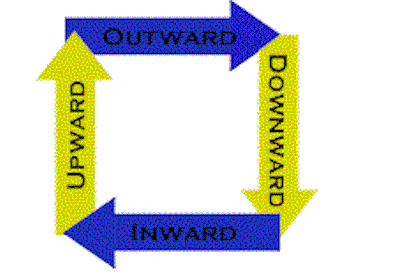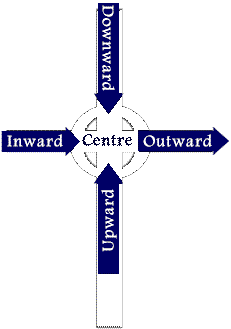The Journey in Four Directions
Becoming involves moving in up to four directions, often simultaneously. These
directions are:
This is the journey of self-discovery and self-knowledge. The ancient oracle at Delphi
in Greece, symbol of wisdom, had the slogan "Know thyself" prominently
displayed; and self-knowledge is a significant part of wisdom (though not, as some
mistakenly believe, the whole of wisdom).
This is the via negativa of the mystics, St John of the Cross's "dark night
of the soul", the emptying taught by most Eastern ways. This is not the whole of
wisdom either, though it is (unfortunately) an indispensable part of it.
So understressed in so many traditions that I will find it difficult to write on. This
is the journey whereby we become for others. Most people who have been really good
at this have not written very much; they have been too busy on the journey. We'll see what
we can come up with.
This most enjoyable journey, too, is understressed in most traditions. It is the via
positiva of Christian mysticism (on which few have written); all of the Eastern
approaches, and for that matter most of the Western, have it so tied to the journey
downward and inward that its significance is obscured or (in my opinion) distorted. Since
I am not a mystic anyway, I will draw largely on non-mystical sources for this section.
| The Journey in Four Directions can be represented as a square
(right). If we are becoming we are always moving in at least one of the four directions.
If we are becoming balanced, we are probably moving in several
if not all of them. If we are serious about becoming, we will probably move in all four,
but the order is not fixed. For this reason, I have taken advantage of the hypertext
medium and not imposed an order on the four sections. Beginning with the one you resist
most is probably a productive approach. |
 |
| The Four Directions by themselves, though, still leave
something out, and that is the centre, the still, silent centre which the
directions are taken to and, in one case, from. So here is another representation, in the
form of a Celtic cross: Why a Celtic cross? For two reasons. The merely
personal one is that I have a number of ancestral links with the Celtic church, as my autogenealogical digression outlines. The more
important reason is the symbolism of the Celtic cross - not just its christian, but its
pre-christian symbolism.
The christian symbolism is clear enough; the Christian Note below explains it if it is
not. The pre-christian symbolism was that the Celtic cross represented the world; the four
arms (which were even in length) were the four cardinal directions, and at the centre,
where the arms met, was the doorway to the Otherworld. |
 |
This is the world of what we would call the supernatural (though this is a
post-enlightenment category that doesn't really apply exactly to the distinction the Celts
were making). This underlines the point I would like to make at length in a digression on
the silent centre.
Where Are We Going?
The Journey in Four Directions is not a journey to a destination where we stop. It is a
journey where the journey - the process - is the important thing. This is not to say that
we never have goals and never arrive anywhere. It is to say that we never finish the
journey.
Christian Note
The first great theologian of Christianity, Paul of Tarsus, summarised the four
directions as follows (taking Christ as the centre, as he always did):
The Journey Inward (a prerequisite)
If you have any encouragement in Christ, if any comfort from his love, if any sharing
with the Spirit, if any gentleness and compassion,
The Journey Outward (a natural expression)
fulfill for me my joy by having the same concerns, the same love, the same soul, the
same preoccupations [as each other]; not out of ambition or empty boasting, but
humblemindedly, considering others above yourselves; each of you not looking out for his
or her own interests, but for the interests of others.
The Journey Downward (a means)
Let the same preoccupations be in you that were also in Christ Jesus:
Who, being in the form of God, did not consider being equal with God a thing to be
seized,
The Journey Upward (a consequence)
Therefore, God lifted him up to the pinnacle
and gifted him with the name above all names,
that at the name of Jesus every knee should bend
in heaven and on earth and under the earth,
and every tongue confess that Jesus Christ is Lord
to the glory of God the Father.
- Philippians 2:1-11 (Paul's Letter to the Church at Philippi, Chapter 2, Verses 1 to
11).
I have also written a liturgical meditation
around the Five Wounds of Christ which uses the ideas of the Journey in Four Directions
and the Silent Centre.
You are visitor number  to this page since
26 April 1998.
to this page since
26 April 1998.
This material is copyright 1998 to Mike
McMillan. Use for profit is reserved to the author unless otherwise arranged.

